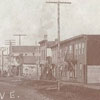The Calgary and Edmonton Railway

In 1890 the construction of the Calgary and Edmonton Railway prompted Frank Oliver to write an editorial entitled "Brightening Prospects": "Ever since work began on the Calgary and Edmonton Railway, with every mile added to the grade, outside interest in this district has risen and every week the arrivals of land prospectors has increased. Land is being taken up in all directions with the town of Edmonton as the centre, and in another year, from present appearance, the taking which are now by quarters or sections will then be by township and blocks of townships."
Construction of the Calgary-to-Red Deer section began on July 8, 1890, and was completed by early December. By March 28, 1891, the Calgary and Edmonton Railway Co. had registered the plans and profile of the line to approximately two miles south of the banks of the North Saskatchewan River. The Edmonton Bulletin observed that this "ensures the location of the terminus at Edmonton, although what is to be the actual site of the terminus is yet a secret, but will be made known in a few weeks at most."
The Edmonton Bulletin's confidence that the Calgary and Edmonton Railway would cross the river ended when route information was made public in March 1891. At the same time that these documents were being filed, the Calgary and Edmonton Railway Co. was secretly acquiring land for the new terminus on the south side of the North Saskatchewan River. The new townsite was originally called South Edmonton but the name was changed to Strathcona when it was incorporated as a town in 1899. The Calgary and Edmonton Railway Company created a new townsite rather than crossing the river into Edmonton in order to monopolise the benefits of future land sales.

In March of 1891 the company had negotiated agreements with Joseph McDonald, owner of river lot eleven, Frederick H. Sache, owner of river lot fifteen A, and Alexander McDonald, John Cameron, and Malcolm and Sarah McLeod, owners of the southern 103 feet of river lot seventeen plus the fraction west half of section twenty-eight. An agreement dated April 6, 1891, covering river lots thirteen and fifteen completed the land arrangements for a townsite by the Calgary and Edmonton Railway Co.
The terms of these agreements for all parties were the same: the owners agreed to provide the Calgary and Edmonton Railway Co. with sufficient land up to a maximum of thirteen and one-half acres for right-of-way and station grounds, plus a half interest in the remaining portion of land, in return for a station and engine shed built by the railway.
The Calgary and Edmonton Railway Co. moved quickly to fulfill the terms of the agreement when the steel reached the location of the proposed townsite in July 1891. By July 25, the survey of the townsite had begun.
The agreements stated that the railway company would survey the townsite with the cost shared equally among the parties. Once the survey was completed, the land could be divided or an agent appointed for the joint sale of all townsite properties.
Plan 1, registered in the Land Titles Office on September 25, 1891, was Edmonton's first south side subdivision.
The streets at the new townsite were named by the Calgary and Edmonton Railway Co. to honour railway and local officials, the original land owners, and prominent citizens of Edmonton and area.
Streets named after railway officials included Whyte (82nd) Avenue and Niblock (105th) Street. Anderson (81st), Sache (88th) and McDonald (83rd) avenues were named after three of the original owners of the townsite land. Main (104th) was the main street running north and south. West (103rd) and East (102nd) Railway streets were located to the west and east of the railway right-of-way. An avenue was even named after Frank Oliver (86th), despite his intense dislike of the Calgary and Edmonton Railway.
This article is extracted from John Gilpin, Responsible Enterprise: A History of Edmonton Real Estate & the Edmonton Real Estate Board. (Edmonton: Edmonton Real Estate Board, 1997). The Heritage Community Foundation and the Alberta Real Estate Foundation would like to thank John Gilpin and the REALTORS® Association of Edmonton for permission to reproduce this material.





